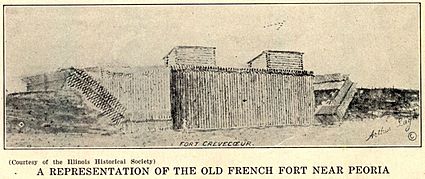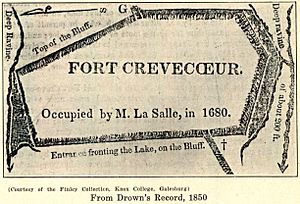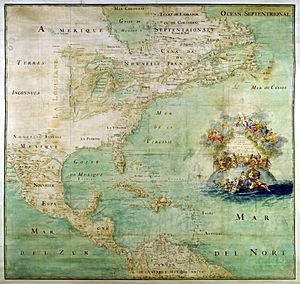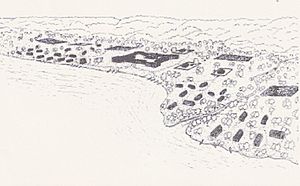Fort Crevecoeur facts for kids
Quick facts for kids Fort Crevecoeur |
|
|---|---|
| Native name English: Fort Crèvecœur |
|
 |
|
| Location | present-day Creve Coeur, Illinois |
| Built | 1680 |
| Rebuilt | Destroyed in 1680 and replaced by Fort Pimiteoui in 1691 |
| Designated | Historical monument constructed January 1, 1920 |
| Part of | Illinois State Historical Society |
Fort Crevecoeur (which means Fort Broken Heart in French) was a very important early fort built by the French. It was the first European building of its kind in what is now Illinois, USA. It was also the first fort built by the French in the western part of North America.
The fort was built in January 1680. It was located along the Illinois River, near where the town of Creve Coeur is today. This area is close to Peoria, Illinois. Sadly, the fort was destroyed just a few months later, in April 1680. Some of the explorers who built it were worried about attacks from the Iroquois people.
Later, in 1691, another fort called Fort St. Louis du Pimiteoui was built nearby. This new fort became an important trading spot for many years. Both forts were strongly connected to Henri de Tonti, a famous French explorer.
Building Fort Crevecoeur
On January 15, 1680, two French explorers, René-Robert Cavelier, Sieur de La Salle and Henri de Tonti, started building Fort Crèvecoeur. They worked hard and finished the fort by early March.
They named it "Fort Broken Heart" because they faced many problems while building it. Some of their crew even left them. A writer named Dr. Daniel Coxe explained in 1719 that La Salle felt "grief" because he lost a valuable ship and some of his crew caused trouble.
La Salle also began building a new ship at the fort. It was meant to replace his ship called Le Griffon, which had disappeared. On March 1, 1680, La Salle left the fort to get supplies. He walked all the way to Fort Frontenac in Canada. He left Henri de Tonti in charge of Fort Crèvecoeur.
Why the Fort Was Destroyed
While La Salle was traveling back, he thought that Starved Rock would be a good place for another fort. He sent a message to Tonti about this idea.
Following La Salle's plan, Henri de Tonti left Fort Crèvecoeur on April 15, 1680. He took Father Ribourde and two other men with him. Their goal was to start building a new settlement and fort at Starved Rock.
The very next day, something went wrong at Fort Crèvecoeur. The seven men who were left behind, led by Martin Chartier, took all the supplies and weapons. They then destroyed the fort and headed back to Canada. When La Salle visited the ruins a few days later, he saw a message written on the unfinished ship: "Nous sommes tous sauvages" (which means "We are all savages").
The men likely left because they were scared. The Iroquois people were attacking local Illinois communities during a time called the Beaver Wars. This was a conflict over land and the fur trade. The men wanted La Salle to return to Canada with them, but he refused. Also, one of the men later said that some of them hadn't been paid in three years and felt La Salle had treated them badly.
After the fort was destroyed, Tonti heard the news from two men who had been there. He sent messengers to La Salle in Canada to tell him what happened. Tonti then went back to Fort Crèvecoeur to gather any tools that weren't destroyed. He moved them to the Kaskaskia Village near Starved Rock.
The men who left the fort also caused more trouble. They stole some of La Salle's belongings at other forts. They then split into two groups, with some even planning to find and hurt La Salle. La Salle did manage to capture some of them later. However, Martin Chartier escaped and lived with a group of Shawnee people in Pennsylvania.
On September 10, 1680, about 600 Iroquois warriors, armed with guns, came to the Kaskaskia village. Tonti tried to talk to them and calm things down. He wanted to give the women, children, and older people time to escape. But an Iroquois man hurt Tonti. The Kaskaskia village was burned, and the Iroquois built their own fort nearby. Tonti and his friends had to leave the area.
Fort St. Louis du Pimiteoui
In 1691, Henri de Tonti returned to the area. He decided to build another fort. This new fort is known by a few names: Fort St. Louis du Pimiteoui, Fort Pimiteoui, or Old Fort Peoria. The name Pimiteoui means "Fat Lake" and refers to what is now called Peoria Lake. This is a part of the Illinois River that becomes much wider.
This new fort became an important place for trade, especially for trading furs. It remained a center for trade and sometimes a settlement throughout the time when France controlled the area.




